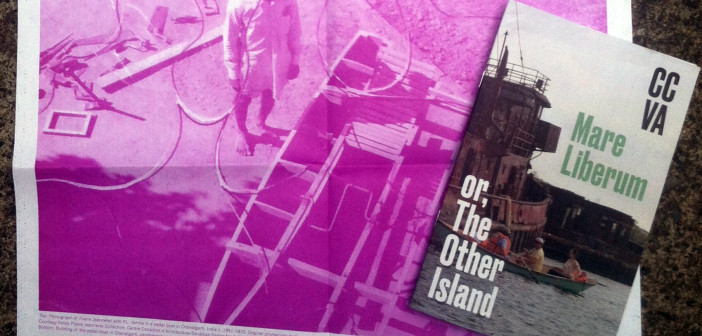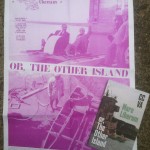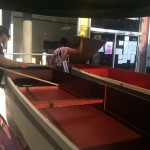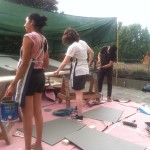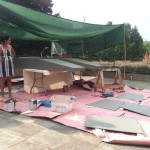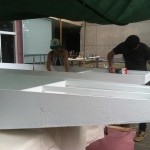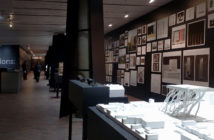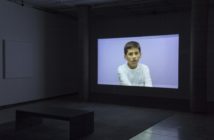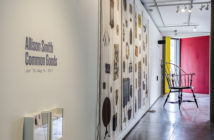Mare Liberum is self-described as “a freeform publishing, boatbuilding and waterfront art collective based in the Gowanus area of Brooklyn, New York.” While the group is in residence at Harvard’s Carpenter Center for the Visual Arts, they continue their ongoing interest in the public use of urban waterways, focusing on a playful, ephemeral photograph of a seafaring Le Corbusier—the architect who famously designed the Carpenter Center—as the point of entry into their work with Boston’s rivers.
The exhibition text—published online, in booklet form, and on the gallery wall—moves quickly through scattered references to Le Corbusier and other sources of inspiration, including Pierre Jeanneret, Tournier’s Friday, or, The Other Island, connecting them to the group’s ecological investigations of water. The actual working pace of the collective and the pace at which dialogue occurs with volunteers and invited guests, however, is loose enough that these relatively obscure materials can cycle through in a number of meaningful ways, even for those new to the conversation. The group’s explicit project is to build a number of boats—primarily flat-bottomed, square-bowed punts—and lead a voyage that brings the public in contact with a number of local, environmentally focused organizations. The activity of the residency offers space to reflect on and reframe the various source materials in the context of the public projects, and it is a real treat considering a show like this could easily wind up thick with a list of references too dense and too subtle for most viewers to parse.
On Tuesday, Mare Liberum hosted the first of two lunchtime talks, this time with Sílvia Benedito, assistant professor of Landscape Architecture at Harvard’s Graduate School of Design. Benedito’s own practice examines the atmosphere of built environments, in terms of both meteorology and vibe. She led a conversation that pushed back against environments that are designed without regard to the preexisting ecology of an area and rallied against trends in landscape architecture that prescribe specific, clearly intended uses for public space to the detriment of open plans that trust the public to shoulder the responsibility of their own haptic experience and fun. Mare Liberum members brought to the table anecdotes of public spaces used in unexpected or unintended ways, reflecting on how didactic landscape architecture can unnecessarily force people to become transgressive.
After the lunchtime talk, an afternoon work session focused on wrapping up two punts that were largely complete. A small portion of the crew, joined by a few volunteers, painted the vessels in red and gray to seal them against the water and attached the gunnels and decking to wrap up construction. Elsewhere, other Mare Liberum members were busy preparing materials for three more punts and building out their Pédalo, a replica of the pedal-powered pontoon boat piloted by Le Corbusier and Jeanneret in that archival image at the root of the project. Throughout the work session, conversation rambled along topics including boats, art schools, Boston’s rivers, and local citizen-led science initiatives. The artists were transparent about the conflicts that come up when attempting to make ecologically sound choices at every level of a project. Even with a decent budget, material costs and related constraints mean choosing between building just one responsibly sourced punt or five boats that do not meet the same standards, but that enable greater participation. Most surprising was that they disclosed this information without overselling their rationale or being unnecessarily apologetic. Their project required that they make choices, and they did. It was an energizing attitude to be around, and there was no self-aggrandizing or false sense of expertise among the group. They are serious about their artistic practice as a method of research and open about what they already know and how much more there is to learn. Member Dylan Gauthier described their method very simply early on in the day: “How do we acquire and synthesize knowledge that we’re around?” It’s a thoughtful approach to learning about the world and a wonderfully accessible tactic to demonstrate in a participatory project.
Mare Liberum’s Or, the Other Island is on view through September 27th and includes works made in residence at the Carpenter Center as well as boats from previous projects. A reception and artist talk is scheduled for Friday, September 11th, and the public launch and voyage on the Mystic and Chelsea Rivers occurs Saturday, September 12th. Registration and more information is available at http://ccva.fas.harvard.edu/mare-liberum-or-other-island. Mare Liberum can be found online at http://www.thefreeseas.org/

